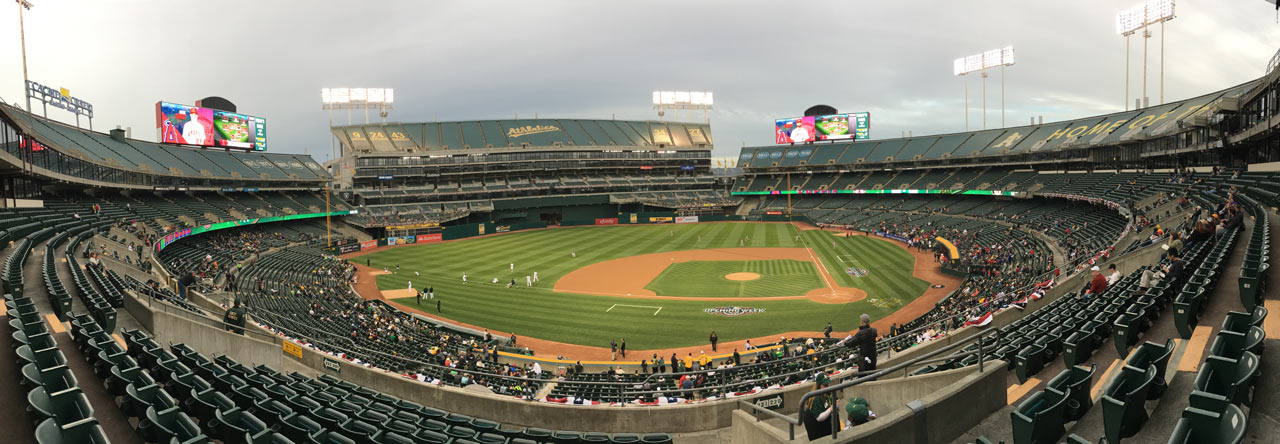Say you wanted to go from Oakland, California to Sacramento, California, a distance of 80 miles, to catch a Friday night Sacramento Rivercats game. (They’re a minor-league baseball team.) And you wanted to take public transit and come back the same night. That seems possible.
Okay, start by getting to the Amtrak station at Jack London Square. Park your bike (or get off the bus) and hop on the train. (Or you could take BART to the Coliseum Amtrak stop.) Depart from the Coliseum at 3:58 pm or Jack London at 4:10 pm to arrive at the Sacramento Amtrak station (401 I Street) at 6:10 pm, for $21 per person.
Then from there, get to Raley Field. It’s exactly a mile from the station, though that includes a river crossing. It seems like a walkable route, though I don’t know if the bridge on the most direct route is open to pedestrians, so it might be slightly longer than a mile. So leave 25 minutes to get there. Oh, there’s also a shuttle. That’s probably a good idea.
Enjoy the game! It starts at 7:05. They’ll probably win, since they’re in first place.
Oh, by the way, you won’t be taking Amtrak back to Oakland, unless you wait till tomorrow, or leave the game super-early. If you don’t take the 9:10 train back to Oakland, you have to wait until 5:40 am for the next one. Since it would be silly to take transit for 4 hours for just 2 hours of a game that would likely last 3 hours, what to do?
Don’t worry. There’s an 11:45 pm Greyhound back to Oakland ($18/person) that puts you back downtown at 1:15 am. The Greyhound leaves from 715 L Street, also 1 mile from the stadium, also across the river. And who doesn’t love Greyhound, especially in the middle of the night?
But the game will be over a little after 10, giving you plenty of time to stroll downtown and maybe grab a beverage on the way to the Greyhound station. (This is all theoretical, sight unseen, by the way.)
So the total for mass transit is $39 per person round trip. That doesn’t count any intra-city transit costs (such as, say, a cab or bus from Amtrak to Raley Field and then back to Greyhound), or any “externalities” (such as getting mugged or something).
Contrast that with a 160-mile round trip by car. At 30 mpg and $3/gallon, it would cost $16 in gas to drive there and back.
So even for just one person, a car is more cost-effective. It would also be a more efficient use of time: You’re not likely to hit a lot of traffic since it’s a reverse commute — and, of course, unlike Amtrak, you can stop right at the stadium.
And, heck, with four people, you would save money renting a nice car. Or maybe taking a limo.
The bottom line is that, though it is possible to determinedly get there and back without a car, it would be much easier with one.
The only possible reason to take Amtrak and Greyhound to and from a Rivercats game would be if you (1) absolutely didn’t have access to a car (or a friend with a car) or (2) really wanted to prove a point.



imnotjesus
while you are right to lament the lack of good inter-city transit in the US, you’re not quite making a fair comparison between the automobile and the train/bus. first, cars cost more than just gas. sure, most people have sunk costs paid into their own automobiles, but they still have to pay maintenance, insurance, parking, etc. these costs, while not made at the point of the trip, are not negligible.
A fairer comparison would be the cost of transit versus the cost of carsharing, which bundles all the costs of auto ownership into one simple fee. Let’s compare, shall we?
mass transit = $39 (or so you say)
carsharing… according to http://www.citycarshare.org
for a 6 hour trip from oakland to sacramento, the average cost would be about $95.
now, any complete discussion of car versus transit has to include time as an additional cost. Transit, as we know, is slower than the car, but also passive. that means you can do other stuff instead of watching for stray SUVs. read a book, do homework, play a video game, safely talk on the phone. so, theoretically, the time spent on transit isn’t 100% “lost”. So, maybe this means that the time spent on transit is roughly equal to the time spent in a car. Of course, this all depends on how much you value your time. For the CEO of Acme Corp, time savings might easily trump everything else. For Joe Non-Profiteer, time may be less valuable. I personally believe time-value is highly variable and the minutes i use writing this comment are worth a lot less then the minutes i need to get real work done. i guess that means i have other stuff to do.
signed,
fakey economist
Gohlkus Maximus
You’re absolutely right, of course. This is just for the purpose of comparing the two trips in a vacuum. Scott may lead an expedition there tonight, and he already has a car, and he probably wouldn’t ask passengers to pay the fraction of his insurance and depreciation they are responsible for — much less the societal externalities.
And, yeah, I didn’t consider City CarShare — even though I am a member, and I love it — mostly because I knew it would be more expensive than the train/bus. (I use CarShare exclusively for intra-Bay Area trips, which either are short or start and end at times that car rental places aren’t open.)